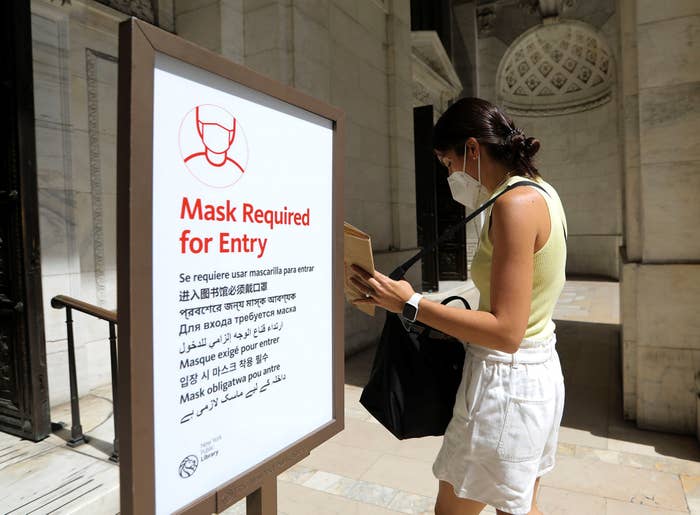
An opinion article published this week in the New York Times that said COVID “mask mandates did nothing” is yet another drop in the misformation bucket, according to doctors and scientists who say the piece depends too heavily on flawed research.
“Those with vested interests are using the same disinformation playbook as tobacco and fossil fuel companies did to sow doubt about the science on COVID protections,” said Lucky Tran, a scientist and public health communicator at Columbia University. “Without public health protections like masks, vulnerable people can’t access essential services like healthcare and public transport safely, and are excluded from public life.”
The research the opinion piece was based on is an analysis of 78 different studies that looked at interventions, including masks and handwashing, to control a variety of respiratory viruses. Although only two of the studies were about COVID and masking during the pandemic, the opinion article states that “mask mandates were a fool’s errand from the start” and only created a “false sense of safety.”
The author, who has a history of “discrediting” science, said the review’s findings “ought to be the final nail in this particular coffin,” despite the fact that the review mentions a number of issues and limitations including that “relatively low numbers of people followed the guidance about wearing masks or about hand hygiene, which may have affected the results of the studies.”
“I took that piece as exactly the kind of political and ideological response you'd expect. Getting some magic bullet evidence to settle the question of whether masks were helpful depends too much on how you wear them, where you wear them, and what mask you use,” said Arthur Caplan, a bioethics professor at the NYU Grossman School of Medicine. “Either we're going to be prudent and use masks in dangerous environments where historically we've seen they've been helpful, or we prioritize liberty — but that's a value, coming to the front, not data.”
COVID spreads through the air, & masks reduce spread Masking together is more effective than masking alone The logic & high-quality peer-reviewed evidence are consistent The major opinion sections are not reliable sources on this matter https://t.co/pd17AjppiA
The research is a Cochrane review, which is considered one of the gold standards for evidence-based medicine; it’s an analysis of many randomized, controlled trials on a particular topic to come to a conclusion about its medical effectiveness.
But the experts we spoke to said these reviews aren’t immune to bias and can have limitations, especially this one.
For example, most of the studies included in the review were conducted before the COVID pandemic during “non-epidemic influenza periods,” such as the H1N1 pandemic and other flu seasons up to 2016. Just six studies were done during the current pandemic but spanned many different countries, including Mexico, Denmark, Bangladesh, England, and Norway, and many different settings, including suburban schools, hospital wards, and low-income neighborhoods.
It’s a classic example of “low-quality studies with poor conclusions getting lumped with higher-quality studies that should be valued more,” said Dr. Dean Blumberg, chief of pediatric infectious diseases at UC Davis Health.
Only 12 studies focused on mask use solely through the lens of mask mandates, but none were able to confirm compliance with those mandates, meaning some people in the studies may not have worn masks properly or at all.
“There is a difference between saying that masking doesn't reduce transmission of respiratory viruses and saying that mask mandates — which were a public health policy decision — didn't significantly reduce transmission. We have been using masks effectively in healthcare settings well before COVID,” said Dr. Abraar Karan, an infectious disease doctor and researcher at Stanford University.
Any study on masking, Karan said, must question whether participants were wearing masks at the time of suspected transmission.
“Otherwise, we are answering a different question, which is whether masks have worked well in real-world settings in which compliance has been poor,” Karan said. “An intervention that you don't use correctly probably won't work well.”
Not to mention, surgical masks and N95 respirators — which vary widely in effectiveness against respiratory viruses — were compared as if they are the same.
“If the original studies are limited and poor and compare apples and oranges, then pulling them together doesn't get you better results,” Caplan of NYU said. “This isn’t the first time I’ve seen a Cochrane review where I remain less than impressed by the findings.”
Caplan also took issue with the fact that individual risks, which play a critical role in how likely someone is to be infected, weren’t considered in any of the studies included in the review.
When it comes to masks, many, many, many studies (the CDC lists 90 of them through 2021) show that they reduce COVID transmission rates, especially on an individual level.
As for community-wide mask mandates, their ability to reduce viral spread has been more difficult to measure.
One study published in the NEJM in November found that schools in Boston that lifted their mask mandates had higher rates of COVID (about 45 more cases per 1,000 students and staff over a 15-week period) than schools that kept them in place. Another study conducted in Bangladesh found that villages with training classes to encourage more people to wear surgical or cloth masks actually helped (43% of people wore masks versus 13% without training). Places with more mask-wearing had lower rates of COVID symptoms and cases.
The Cochrane review did not include the NEJM study, but did include the one from Bangladesh. It also included a 2020 study conducted in Denmark, where 4,800 people were randomly assigned to wear a surgical mask at a point in the pandemic when there was a modest COVID infection rate, social distancing, and few people in general wearing masks. There were a similar number of COVID cases (about 2% of people) in both groups. About 46% of people said they wore their masks as directed, 47% mostly as directed, and 7% not at all.
“I don't think we're ever going to get pure, uncontroversial evidence about masks,” Caplan said, “because the virus changes, vaccination status varies, and mask behaviors are all over the place.”
That said, experts aren’t claiming that masks are perfect, or that if you wear one you’ll definitely never catch a respiratory virus. But wearing one properly can lower your risk of getting sick.
It’s like using an umbrella when it's raining; it won’t stop you from getting wet, but it will prevent you from getting soaked. And the better quality umbrella you use (think N95 versus cloth mask) the better that protection.
“Masks and mask mandates remain a key tool for keeping society open and accessible to everyone,” Tran told BuzzFeed News, “especially for people at higher risk."
